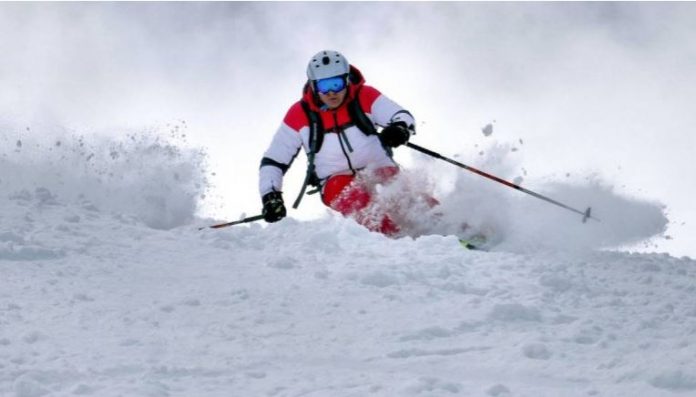OSLO – If you’ve heard the saying that Norwegians were born with skis on their feet, it may not come as a surprise that the country is a nation of skiers.
From the de facto national sport, cross country skiing, to alpine (downhill), to ski-jumping, and beyond, Norway seems to have championed them all!
But how did such a small nation get so good at this sport, and why are they so obsessed with it?
The answer lies in the climate, their ancestors, and their connection to nature.
While the origins of skiing can be traced to China, the earliest evidence of skiing in Norway is a rock carving estimated to be around 6000 years old.
Discovered in 2001 and known as the Bøla Man, the carving shows a human on skis with one pole in his hand.
The single pole is thought to have been used as a paddle, demonstrating that skiing was already prevalent at this time.
A second carving known as the Rødøy Man was discovered in 1933 and is dated to 2000 BC. The carving depicts a figure on skis.
It became the inspiration for a worldwide sporting event, as we will see later.
793 – 1066: The Vikings and Old Norse
Did you know that the term “ski” comes from the Old Norse word, “skíð,” meaning cleft wood?
Outside of pillaging, the Vikings found some time to worship the many Norse Gods and Goddesses.
Among them were Ullr and the giantess Skadi, both of whom are documented in Norse folklore for their skiing ability.
In reality, heavy snowfall meant that skiing was a necessary means of transport during the Viking Age.
A good area for hunting was high up in the mountains, but there was only one way down, which required skilled navigation.
The Vikings combined elements of alpine and jumping to ensure a safe descent from their hunts.
1204: The Prince and the Birch Legs
Fast-forward 138 years, and a civil war is now raging between two groups, the Baglers and the Birkebeins.
The name Birkebeins, meaning “birch legs,” was intended to be negative – referring to their use of birch bark as proper footwear, indicating their low status.
They supported the ruling King Haakon Sverressons and appointed him the leader of their group.
When he died, the king’s new-born son and heir to the Norwegian throne, Håkon Håkonsson, became a target for the Baglers.
Worried about the infant in danger, a group of Birkebeiners planned to carry young Håkon to safety on skis, but only the two best skiers could go due to bad weather.
Together, they completed a treacherous 54km journey and secured Håkon’s ascent to the throne.
This piece of history is commemorated by the annual skiing event, Birkebeinerrennet.
All participants carry a backpack weighing 3.5 kg, symbolizing the weight of the infant.
In 2015, the event came full circle when Norway’s Crown Prince Haakon became the first member of the royal family to participate in the race.
You can find out how he got on here!
The 1800s: Norway gets modern
Although records exist from the Danish-Norwegian army of military ski exercises, it was not until the 1800s that civilians took up skiing for leisure.
The oldest officially recognized ski race for civilians is considered «Veddeløb paa Ski» (Betting Run on Skis), which took place in Tromsø in 1843.
From this date onwards, its popularity exploded across Norway, and the first ski club was founded shortly after.
Around the same time, a new type of skiing emerged from the county Telemark.
This modern technique is attributed to Sondre Norheim, dubbed the Father of Skiing for his pioneering skills and technical innovations that would later propel Norway onto the world stage of skiing.
1905: New rulers
Following independence from Sweden in 1905, the Norwegian government identified suitable candidates for the Norwegian Crown.
It had been over 500 years since Norway had had its own king.
After some discussions, the Danish Prince Haakon VII and his English wife, Princess Maud, emerged as the new King and Queen of Norway.
Aware of the need to adapt to a new country and much to the delight of Norwegians, they quickly found a cross-country skiing instructor as well as a friend in the explorer, Fridtjof Nansen.
The Royal couple instilled their love for the sport in their son, Crown Prince Olav.
He is fondly remembered as Norway’s Ski King and, on two occasions, he even took part in the Holmenkollen ski jump competition!
1924 and 1994: Winter Olympics
Winning a total of four gold medals in skiing, Norway proved victorious in the first Winter Olympics hosted by France.
Since then, the country has gone on to win the Games an additional eight times, more than any other country in the world.
A total of 70 years after the first competition, it was Norway’s turn to host. Remember the rock carving of the Rødøy Man? That was the inspiration for the pictograms for each sport, designed to highlight their proud heritage.
1943: The heroes of Telemark
In April 1940, the Nazis invaded neutral Norway and, a month later, seized Vemork hydroelectric power plant in Telemark.
The facility became the basis for initial research into atomic bomb production, which caused growing concern among allied forces.
Britain formed the Linge Company, a group of talented Norwegians, to undertake raids against the Nazis.
One such raid would be the plant.
A failed mission by Britain to detonate the facility had already resulted in 41 deaths.
Determined, they called on the Linge Company for help, and Operation Swallow/Gunnerside was born.
Both operations succeeded, but with 2,800 Nazis in pursuit, the groups had to escape quickly.
By sunrise, the saboteurs were well clear, five of whom skied cross-country for 14 days, covering 280 miles before reaching neutral Sweden.
Conclusion
With such a long history, skiing is entrenched in the Norwegian way of life.
Although the participation for leisure purposes is less, Norwegians remain proud of their heritage, and Norway’s athletes remain at the top of their game.


















